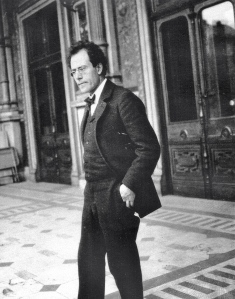You are currently browsing the tag archive for the ‘sixth symphony’ tag.
I listened this morning to Alfred Schnittke’s Symphony No. 6 (1992).
Even though there is masterful polyphonic writing as well (as can be expected from Schnittke), most of the time the music is homophonic or quasi-homophonic, especially in the slow first and third movements. Each of the three basic orchestral groups of brass, woodwind and strings plays almost all the time isolated from the other groups (the faster movements seem a bit more communicative between the orchestral groups, or at least they alternate more quickly). A given musical gesture in the brass may thus, for example, be answered by another gesture exclusively played in the strings which in turn is answered by another one exclusively played in the woodwind, etc. Often, however, gestures are answered within the instrumental group itself.
The musical gestures are often sparse and there are frequent small pauses or onsets of new breath in the musical accentuation. Add to this the often homophonic writing with mostly no gestural accompaniment and the playing of the orchestral groups apart from each other, and the result is that individual gestures are very isolated. In this manner each one of them acquires a searing intensity that might be possible to a lesser extent in a denser score. Schnittke here makes a powerful and convincing argument for the motto “less is more” (even though by no account I would want to miss the complex density of other – including Schnittke’s – modern scores).
The intensity of the gestures is enhanced by the impression of granite-like rightness with which contrasting gestures succeed each other. The harmonic language of the symphony is very powerful and the harmonic accents of each individual gesture are beautifully and tightly controlled, which adds to the impact.
The music sounds cutting-edge modern, clearly more modern than some recent scores by established “modernists”. It strikes me as an exercise in writing a symphony entirely without the filler that many symphonic works have; hence the argument is often bald, textures aren’t filled out, and silences often intrude.
This symphony is every bit the masterpiece I remembered it to be, and more. It deeply impresses me.
Said to be a musical portrait of Stalin, this music speaks of cruelty and terror.
It is also fucking loud.
I saw Solti with the Chicago Symphony Orchestra back in the day performing Mahler’s Symphony No. 6. It was fucking loud.
Incidentally, the London Symphony Orchestra gave Solti a nickname: “The Screaming Skull”.
The Australian conductor Sir Charles Mackerras, who led the opening concert at the Sydney Opera House and was the first non-Briton to lead the Last Night of the Proms, has died in London at the age of 84.
Charles Mackerras was born in the US and raised in Australia before coming to England to study music.
Though internationally acclaimed, he disdained stardom and missed out on the plum post at Covent Garden.
He had become maybe my favourite conductor over the last few years. What a great man – great conductor, great musicologist, great reader and lover of music, great arranger too (Pineapple Poll). This is really sad news. He was the one conductor among the current generation of 80-somethings I was hoping would live longest; sorry, Haitink, Harnoncourt, etc. Not least because he was due to perform Berlioz’s Symphonie Fantastique, Mozart’s 40th and Schubert’s 4th in London this year – concerts which, since I’m moving to London, I was expecting to be the best nights of my year.
I don’t think I ever heard a recording of his that was not good, whether it was 18th 19th or 20th Century – he seemed to bring a fresh and exciting and always musically rewarding interpretation to the works he conducted.
It is very sad news, but he had a long and full life and left behind a great recorded legacy; you can’t ask for much more than that.
I recall an excellent concert at the Bridgewater Hall in Manchester nearly ten years ago, where Sir Charles conducted Mahler’s Sixth Symphony with the BBC Philharmonic Orchestra. This was issued on CD with the BBC Music Magazine about a year later and I recalled how special and heartfelt the performance was. It is this, which I am spinning now, preparing for Mahler’s Eighth Symphony from the BBC Proms tonight. Great memories, great performance, very sad loss.
R.I.P. Alan Charles MacLaurin Mackerras, conductor, born 17 November 1925; died 14 July 2010
Related:






Recent Comments